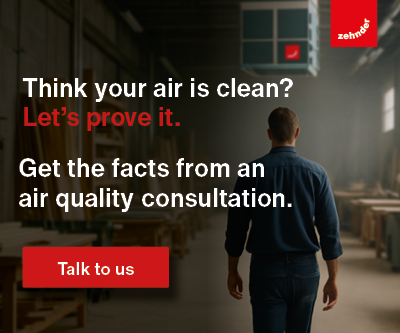The air we breathe is rarely a problem. Until it is.
In the woodworking industry, dust is simply part of the job. It’s a symbol of something being made, shaped, brought to life. Most people barely think twice about it – until the moment it can’t be ignored. That’s when a persistent cough becomes more than just a nuisance. That’s when another employee heads home early, complaining of a tight chest. That’s when you realise the real danger isn’t the dust you can see, but the invisible particles that linger long after the work stops.
Because, the air we breathe is rarely a problem. Until it is.
The unspoken risk in every workshop
Across woodworking shops in the UK, extraction systems hum and COSHH files are up to date. PPE hangs on hooks, ready for use. On the surface, everything appears safe and compliant.
And yet – the air isn’t clean. Not really.
Zehnder Clean Air Solutions recently conducted a series of air quality measurements in real workshops – not just at the bench, but in places you wouldn’t expect to matter: walkways. The results? Shocking.
In many areas, the air pollution was higher than directly next to the machines. Dust migrates, drifts, and accumulates in places where no one wears protection – because no one expects to need it.
So what’s really going on?
Many in the woodworking industry assume that having dust extraction in place means the problem is solved. But that’s exactly the issue, as local extraction only captures dust at the source. It can’t deal with what escapes and plenty of fine particles do slip through. The most dangerous ones are often the smallest, lingering unseen in the air long after the work stops.
They float. They drift. They linger – long after the sawing stops.
Even workers using protective gear aren’t completely safe. Why? Because masks aren’t always worn properly, sometimes aren’t worn at all and often can’t filter the tiniest particles (those smaller than 2.5 microns).
We call this Pedestrianism
It’s a term we’ve coined to describe the exposure of people who aren’t even handling wood – people walking through, working near, or simply sharing the same building.
Designers. Admin teams. Clients.
They don’t saw, sand, or sweep – but they inhale the same air.
The tragedy is: it looks clean. It smells safe. It feels compliant. But compliance doesn’t equal protection. And dust doesn’t need permission to do harm.
A new standard for safety
It’s time to stop accepting dust as “just part of the job.”
Because dust that you can’t see is still dust that can do damage.
Our campaign doesn’t aim to scold. It’s here to inform, support, and help woodworking businesses across the UK take their next step forward.
We’ve created a practical guide:
“Sawdust and safety” – a free download packed with insights, real-world stats and easy-to-understand actions any workshop can take.
Because health shouldn’t be a matter of luck – or legal minimums.
Download the sawdust and safety guide
Zehnder Clean Air Solutions is a global leader in workplace air quality management. With over two decades of experience, it specialises in providing innovative air purification solutions that create cleaner, healthier, and safer working environments. Its advanced systems remove harmful airborne particles, improving employee wellbeing, operational efficiency, and overall productivity. The company is dedicated to making a measurable difference in the lives of workers and supporting businesses to thrive by prioritising clean air. For more information, visit www.zehnder-cleanairsolutions.com











